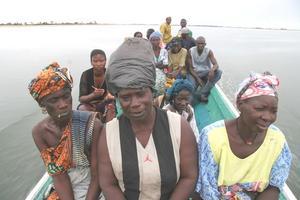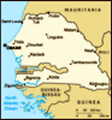Advertisement
Published: October 16th 2006

 20 People In A Boat
20 People In A Boat
Returning from planting 4500 mangrove trees. The water is smooth as glass - very different from 3 hours earlier.A Storm In A Pirogue
My first truly free weekend since arriving in Senegal and I was really excited at the prospect of getting out on the water in a Pirogue, the long narrow motorised canoes which have hit the news recently as desperate people make desperate efforts to reach the Canary Islands. Our pirogue was designed to carry 20 people but felt amazingly unstable with just ten. The ones tackling the Atlantic storms can hold 40 but are often crammed with almost double that number and end up breaking their backs in the Atlantic swells.
A beautiful sunny morning with the prospect of a boat trip and replanting an area of devastated mangroves with local villagers - perfect start to the weekend. As we strolled through town to meet the “Piroguier” I could feel the smile on my face - I love getting out on the water and I’d been surrounded by it for too long. Behind me, a bank of boiling black clouds silently crept over the horizon.
We sliced through the flat calm delta, fish leaping out of the water all around us, and, for once, my hosts all seemed to be getting along, their

 Sunny Start
Sunny Start
We set off from Foundiougne on smooth water with clear skies. Nice and toasty in my life jacket.minds focussed on the “reboissement” project ahead.
A quick stop at the next village on the river to pick up some helpers gave me the chance to get some photos of the huts perched just half a meter above the high tide line with the now simmering clouds looming ever closer behind them.
Storms are strange things. They fester miles away looking impressive but harmless and then they turn on you in a matter of minutes. As we followed the Saloum river towards Kaolak, the first fingers of low dark clouds grasped the air above us, accelerating and, without and other points of reference, seeming to slow the pirogue’s progress to a standstill. Our Piroguier knew the signs and tried to cut a course that would take us head first into the wind when it came. I buried my camera deep inside layers of plastic bags inside my rucksack. I’ve been here long enough to know that the combined power of the wind and rain can take on the best power shower at home.
The wind arrived like a blast wave, whipping the water into white streaks and deep ripples in a matter of seconds. Then the

 Storm On The Horizon
Storm On The Horizon
As we set off from our first village stop, the clouds started their sprint towards us.rain - a grey streaked wall of water rushing towards us carried by the growing winds. Khadi grabbed the bailing bucket to protect her video camera. When it hit, the rain slapped against the wooden boards of the pirogue and stung our heads and ears with icy drops. The water around us started to dance. The rain grew more intense and soon we were caught in a white out. The waves quickly grew to about 2 feet (remember this is on a river in a glorified canoe) and started to break over the sides of the pirogue. We couldn’t prize the bucket from Khadi’s grasp so we had to use our hands. We put the anchor out and I started to get a bit worried. We couldn’t see more than about 6 feet in any direction and by now it was impossible to tell if it was actually the rain that was falling or if river was trying to leap up into the clouds. I was soaked to the skin in a couple of minutes and, for the first time since arriving in Africa, was freezing cold. A few people jumped in and held on to the pirogue to warm

 Time to hide the camera
Time to hide the camera
The storm closes in and we brace ourselves for a battering.up (the river was MUCH warmer than the rain). The squall lasted a good 30 minutes and, when it passed, was replaced by a cold wind and grey skies - no sign of a drying sun.
When the waves calmed a little and the dancing spray cleared, we headed for the nearest bank - which happened to be where we were trying to land. A line of shivering, soaked volunteers, including one very pale Englishman with chattering teeth, made their way across the saturated sand to a village enclosure, once a French fort and now housing two families.
There was nowhere to dry off and barely any shelter from the wind. I hadn’t felt this cold since being thrown out of the Hampton Pier Sailing Club rescue boat, in the middle of winter (that’s how I remember it anyway) aged about 10, with no wetsuit, and being told to swim to shore. A small fire in the kitchen produced more smoke than heat and, with space for only two people, I decided to wring out my clothes, item by item, put them back on cold and damp, and then persuade the local kids to teach me some dance

 Preparing "Propogules"
Preparing "Propogules"
The "propogules" normally drop from the trees into the surrounding mud. We gathered propogules from a healthy area of mangrove and used them to plant a hectare of new forest. Here one of the villagers, gets the propogules ready for planting.moves to warm up. Once again, strange dance moves saved the day. I can now do the threatening dance of a Senegalese traditional wrestler - London nightclubs beware!
Playing In The Mud
After trying to dry out for a couple of hours, the clouds finally started to lift and the sun started to break through. Still damp, we headed back to the boat with an army of villagers to replant an area of mangrove on the opposite bank which had been completely destroyed for firewood over the years by the villagers themselves. “Reboissement Des Mangroves” is one of WAAME’s biggest and most successful projects and you can see young mangrove forests re-establishing themselves all around the delta.
Seeing the decomposed roots of the old mangroves really brought home the importance of reducing reliance on wood for cooking - one of the objectives of the solar project I’m working on. Not just the environmental impact of using fuel wood but the incredible time and toil involved in going out to find, collect and carry it back - a burden usually carried by the women and children of the village.
The pirogue now had 20 people in it and

 Planting "Propogules"
Planting "Propogules"
One of the Fayako villagers helping us to replant a hectare of destroyed mangroves.was barely out of the water. If anyone moved, the water lapped over the gunnels and the bailing bucket worked like crazy. Fortunately the water was now flat calm and everyone sat still. Stepping out of a boat, feeling the river bed and then feeling your foot continue sinking another 2 feet is disconcerting! It feels like it will never stop as it pushes down through the mud scraping against strange objects (Worms? Shells? Fish?) before eventually slowing and finding a firmer sandy base. Trying to wade through water and mud and keep my camera out of the water was tricky but I managed to scramble up onto the mud flat only to immediately sink up to my knees in black, brown and red stinking mud.
With a team of 20 people, we planted about 4,500 mangrove “seeds” in about an hour and a half - covering just under 1 hectare. Finally got the hang of walking on the old root systems of the dead mangroves and managed to get some good photos (posting soon).
The villagers have now been taught how to manage their mangroves in a sustainable way in the future and seemed keen to keep

 MUD !
MUD !
Me up to my knees in the stuff.replanting bigger areas. After feeding those of us not fasting for Ramadan, we got a big grateful send off from the pier.
Walking through mud that deep is exhausting work and, as we passed the newly replanted banks on our way back to Foundiougne, I felt that satisfying kind of tiredness you sometimes feel after a long run. The seeds should start growing in about 2 weeks and I hope to be able to go back and see how much of the new forest survives.
Advertisement
Tot: 0.127s; Tpl: 0.011s; cc: 12; qc: 79; dbt: 0.0719s; 1; m:domysql w:travelblog (10.17.0.13); sld: 1;
; mem: 1.2mb







